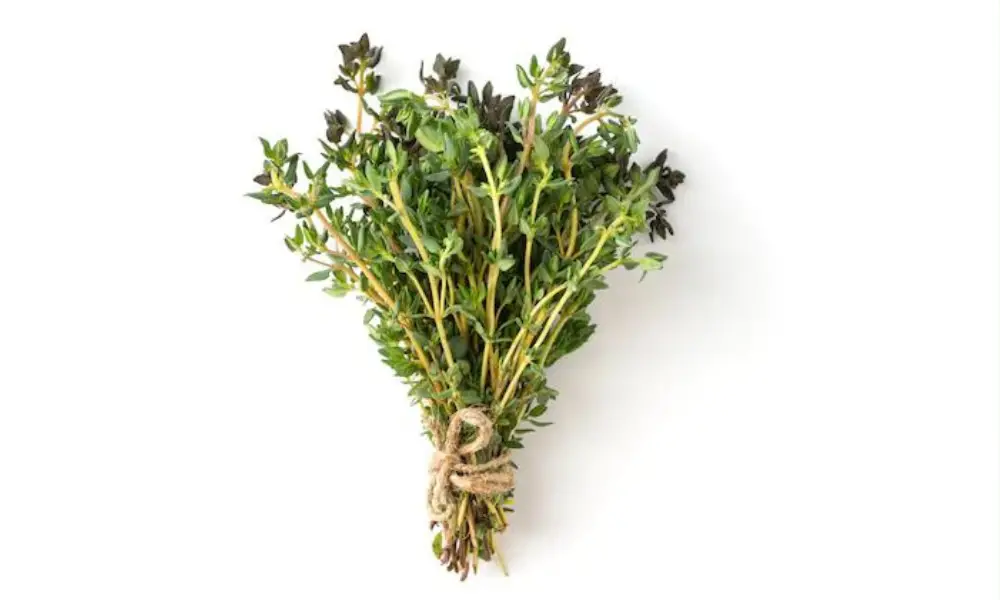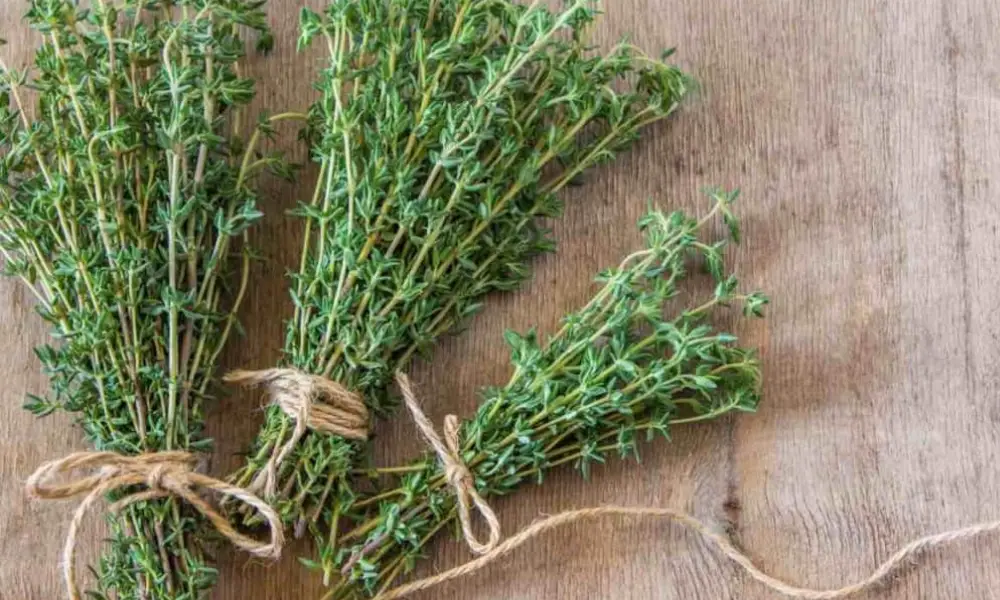You can buy thyme fresh or freeze it for later. Here are some tips to ensure that your thyme will stay fresh and aromatic. To freeze thyme, you can first clean them. After cleaning, you can add the dried or air-dried leaves to a bouquet garni mix and store it in the freezer. When you use it, you should add it to your dishes while cooking to give an instant boost to their flavor.

Thyme: What is it?
Thyme is a Mediterranean herb that can be grown for ornamental purposes and used medicinally. With the help of its flowers, leaves, and oil, thyme has been utilized to treat various ailments and issues. They include sore throats, arthritic pain, diarrhea, and stomach discomfort, with Thymus vulgaris being the most common. Online shoppers can get thyme products in a variety of formats.
Wild and thyme are not the same plants and should not be mistaken. Thyme has compounds that may help treat bacterial and fungal infections and have antioxidant and anti-inflammatory capabilities. There is no scientific evidence to support the widespread use of thyme as a remedy for coughs, alopecia areata (patchy hair loss), dementia, and other illnesses.
How to Freeze Thyme?
Your Freshly Cut Thyme Can be Frozen
Culinary thyme’s robust, perennial nature makes it ideal for freezing. Many delicate herbs may lose their treasured texture when thawed, but robust thyme doesn’t. Thyme is also utilized early in the cooking process, so the texture is not a problem.
No need to chop; take fresh thyme leaves and put them in ice cube trays. Put water on top of them, then freeze. Place the whole thyme stems in freezer bags and freeze them if you want to utilize whole thyme leaves. Whole leaves can be frozen and will easily detach from the stem. After being frozen, transfer the cubes to freezer bags and use them as “flavor bombs” in winter stews and roasts or as a base for soup.
In the Refrigerator
Because of thyme’s hardiness, you may place it in a resealable container and place it in your refrigerator without taking any further safety measures. It should continue to be functional for a few weeks.
Roll the thyme in a wet paper towel and store it in a sealable plastic bag to keep the flavor fresh even longer.
The third choice for long-term storage is to arrange your thyme sprigs in a drinking glass or jar with about an inch of water, standing them up like a bouquet. You can store them in your refrigerator in this manner or choose a larger resealable container to prevent spills if it tips over.
By performing frequent water changes, you may use this technique to keep your thyme fresh for three months or longer.
Freezing Thyme
Put the sprigs in a freezer bag and store them there. The leaves will be simple to separate from the stems after you take the thyme out of the freezer. Poke a fork through the stems, or use your fingers to remove the leaves. Thyme is hardy enough to endure freezing without losing any of its flavor or texture.
The same ice cube technique that works so well with other herbs can also be used here. First, you should separate the stems’ leaves. When using fresh, unfrozen thyme, grasp the stems between your thumb and forefinger and pull your fingers along the stem to break off the leaves rather than using a fork. Fill an ice cube tray with water and add the leaves. The tray should be put in the freezer. Remove the cubes from the tray and put them in freezer bags after they have solidified. To enjoy the flavor of fresh thyme whenever you want, stir one of these cubes into a meat stew or pasta sauce.
How to Dehydrate or Dry Your Thyme?
One of those amazing herbs, thyme, keeps many of its beneficial, natural properties even after drying. Air drying and oven drying are two additional effective drying techniques. However, I like the simplicity and uniformity of using a dehydrator.
I make a “yard blend” out of all the herbs I’ve dried from my garden each year. Depending on what grew best, the flavor profile varies yearly, but thyme is a constant strong ingredient. Consider creating a traditional Italian seasoning or herbes de Provence blend if you are drying or dehydrating other herbs from your garden.
- One herb that keeps a lot of its flavor when dried is thyme. A food dehydrator is the quickest method for drying thyme. Set the dehydrator’s temperature to 90–100 degrees. To catch any leaves that fall from the stems while drying, use a fine screen on the dehydrator trays. It can take your thyme anywhere from one to three hours to dry entirely. After the first hour, start monitoring it every half-hour. It is prepared to emerge when the leaves fall off readily. The leaves should be separated from the stems and stored in airtight containers.
- Drying it out in the open air is another simple method. A paper bag with holes should be placed over the thyme bunch. The bunch should be hung in an area with dry, moving air. The bag will keep your thyme from becoming dusty and collect any leaves that drop off. Your thyme should be dry and prepared for storing after around ten days.
- Thyme can also be dried in a microwave. Microwave for 30 seconds at a time. On dry paper towels, arrange the sprigs in a single layer. Turn and reposition the sprigs in between each session.
- Thyme can also be easily dried in your oven. Place the thyme sprigs on a baking sheet in a single layer and preheat the oven to 180 degrees. With the oven door open, put the baking sheet inside. For about two hours, leave them inside. After the first hour, check on their dryness every 30 minutes.
How to Spot a Bad Thyme?
Your thyme will eventually lose its freshness and exhibit indications of deterioration. Pay attention to the following details to determine whether it is fresh or not:
Discoloration
Check the spice, fresh or dried, for any discoloration. If there is any discoloration, such spice is potentially dangerous. Throw them out right away. Look for any wilted sprigs if there are some as well. Throw away such a veggie right away.
When Thyme Appears Too Soft
Touch, grasp, and feel the fresh veggie spice to get a sense of its texture. Fresh spice is unpleasant when it feels sticky, slimy, and mushy. Throw them out right away. Squeeze the spice lightly to check if it feels scratchy and dusty if it is dried. Throw them out right away.
Off Odor
Grab a spice and smell it (dried or fresh). The spice is rotting and needs to be thrown away if you smell anything foul, smells awful, or no longer has the same spicy aroma it once did.
Poor Taste
Grab a mouthful of this fantastic spice. If the flavor of a such spice is off or different from how it usually tastes, it is unpleasant. Please don’t use them again and dispose of them immediately.
How Long does Thyme have a Shelf Life?
If properly maintained in the circumstances required on the counter, dried thyme lasts 7 to 8 months before going bad. If carefully stored in the ideal circumstances required in the refrigerator, raw dried thyme keeps for one to two years before going bad.
If stored properly in the required conditions in the freezer, dried thyme keeps for three to four years before going bad.
Store dried spices on the counter, which will last for months or even years, to achieve longer storage. Since that is a long period for storage, it is not a great concern to store dried thyme there in its raw state. However, keep it out of excess moisture and sunlight to prevent it from becoming watery.
How do You Keep Thyme?
Cooling is necessary if you want fresh thyme to last longer than a few days. Please keep it in a plastic bag with a wet paper towel for optimal results. It is best to keep dried thyme properly wrapped in a cool, dry location. It’s not difficult to store dried thyme; all it requires is a place away from moisture.
Things are a little trickier when it comes to fresh thyme. Yes, you can put the whole batch in the refrigerator, but it is far from ideal. The safest strategy for long-term storage of dried spices is always to store them in an airtight container.
Can You Still Use Old Thyme?
Thyme doesn’t last very long, like any fresh herbs. The best-dried thyme lasts between six and twelve months, although you can use it for weeks, months, or even years. You may anticipate maintaining its quality in the refrigerator for 7 to 14 days, depending on how you store it.
You won’t get sick from harsh, depressing, flavorless spices like thyme. The truth is that while your spices may be bad, they are still fresh. Although the spice’s expiration date on the bottle is crucial for monitoring freshness (remember that freshness equals flavor), you can still use the spice after that point.
Conclusion
Once frozen, thyme keeps for months in the freezer and is ready for use whenever you need a fresh sprig. Another great method for preserving thyme is drying it. This method can keep the herb fresh for months while saving you money. Thyme can last for up to 6 months if properly preserved and stored. Remember that thyme will lose some flavor if stored too long and can develop freezer burn.

